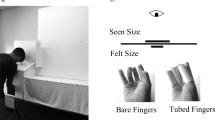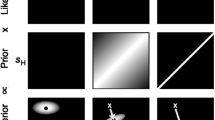Abstract
Many tasks can be carried out by using several sources of information. For example, an object’s size and shape can be judged based on visual as well as haptic cues. It has been shown recently that human observers integrate visual and haptic size information in a statistically optimal fashion, in the sense that the integrated estimate is most reliable (Ernst and Banks in Nature 415:429–433, 2002). In the present study, we tested whether this holds also for visual and haptic shape information. In previous studies virtual stimuli were used to test for optimality in integration. Virtual displays may, however, contain additional inappropriate cues that provide conflicting information and thus affect cue integration. Therefore, we studied optimal integration using real objects. Furthermore, we presented visual information via mirrors to create a spatial separation between visual and haptic cues while observers saw their hand touching the object and thus, knew that they were seeing and feeling the same object. Does this knowledge promote integration even though signals are spatially discrepant which has been shown to lead to a breakdown of integration (Gepshtein et al. in J Vis 5:1013–1023, 2005)? Consistent with the model predictions, observers weighted visual and haptic cues to shape according to their reliability: progressively more weight was given to haptics when visual information became less reliable. Moreover, the integrated visual–haptic estimate was more reliable than either unimodal estimate. These findings suggest that observers integrate visual and haptic shape information of real 3D objects. Thereby, knowledge that multisensory signals arise from the same object seems to promote integration.






Similar content being viewed by others
References
Alais D, Burr D (2004) The ventriloquist effect results from near-optimal bimodal integration. Curr Biol 14:257–262
Bertelson P, de Gelder B (2004) The psychology of multimodal perception. In: Spence C, Driver J (eds) Crossmodal space and crossmodal attention. Oxford University Press, Oxford, pp 151–177
Blake A, Bülthoff HH, Sheinberg D (1993) Shape from texture: ideal observers and human psychophysics. Vision Res 33:1723–1737
Bresciani JP, Ernst MO, Drewing K, Bouyer G, Maury V, Kheddar A (2005) Feeling what you hear: auditory signals can modulate tactile tap perception. Exp Brain Res 162:172–180
Buckley D, Frisby JP (1993) Interaction of stereo, texture and outline cues in the shape perception of three-dimensional ridges. Vision Res 33:919–933
Clark JJ, Yuille AL (1990) Data fusion for sensory information processing systems. Kluwer, Dordrecht
De Gelder B, Bertelson P (2003) Multisensory integration, perception and ecological validity. Trends Cogn Sci 7:460–467
Ernst MO, Banks MS (2002) Humans integrate visual and haptic information in a statistically optimal fashion. Nature 415:429–433
Ernst MO, Bülthoff HH (2004) Merging the senses into a robust percept. Trends Cogn Sci 8:162–169
Gepshtein S, Banks MS (2003) Viewing geometry determines how vision and haptics combine in size perception. Curr Biol 13:483–488
Gepshtein S, Burge J, Ernst MO, Banks MS (2005) The combination of vision and touch depends on spatial proximity. J Vis 5:1013–1023
Helbig HB, Ernst MO (2007) Knowledge about a common source can promote visual-haptic integration (submitted)
Hershberger WA, Misceo GF (1996) Touch dominates haptic estimates of discordant visual–haptic size. Percept Psychophys 58:1124–1132
Hillis JM, Watt SJ, Landy MS, Banks MS (2004) Slant from texture and disparity cues: optimal cue combination. J Vis 4:967–992
Jacobs RA (1999) Optimal integration of texture and motion cues to depth. Vision Res 39:3621–3629
Jacobs RA (2002) What determines visual cue reliability? Trends Cogn Sci 6:345–350
Kerst SM, Howard JH (1978) Memory psychophysics for visual area and length. Mem Cognit 6:327–335
Klein RE (1966) A developmental study of perception under conditions of conflicting sensory cues. Diss Abstr 27:2162B–2163B
Knill DC, Saunders JA (2003) Do humans optimally integrate stereo and texture information for judgments of surface slant? Vision Res 43:2539–2558
Landy MS, Kojima H (2001) Ideal cue combination for localizing texture-defined edges. J Opt Soc Am A Opt Image Sci Vis 18:2307–2320
Landy MS, Maloney LT, Johnston EB, Young M (1995) Measurement and modeling of depth cue combination: in defense of weak fusion. Vision Res 35:389–412
McDonnell PM, Duffett J (1972) Vision and touch: a reconsideration of conflict between the two senses. Can J Exp Psychol 26:171–180
Miller EA (1972) Interaction of vision and touch in conflict and nonconflict form perception tasks. J Exp Psychol 96:114–123
Moyer RS, Bradley DR, Sorensen MH, Whiting C, Mansfield DP (1978) Psychophysical functions for perceived and remembered size. Science 200:330–332
Power RP, Graham A (1976) Dominance of touch by vision: generalization of the hypothesis to a tactually experienced population. Perception 5:161–166
Rock I, Victor J (1964) Vision and touch: an experimentally created conflict between the two senses. Science 7:594–596
van Ee R, Banks MS, Backus BT (1999) An analysis of binocular slant contrast. Perception 28:1121–1145
Wichmann FA, Hill NJ (2001) The psychometric function: I. fitting, sampling, and goodness of fit. Percept Psychophys 63:1293–1313
Yuille AL, Bülthoff HH (1996) Bayesian theory and psychophysics. In: Knill D, Richards W (eds) Perception as Bayesian inference. Cambridge University Press, Cambridge
Acknowledgments
This work was supported by the Max Planck Society, by the 5th and 6th Framework IST Program of the EU (IST−2001-38040 TOUCH-HapSys & IST-2006-027141 ImmerSence) and the SFB550. We wish to thank the participating volunteers and K. Mayer and A. Reichenbach for help with conducting the experiments.
Author information
Authors and Affiliations
Corresponding author
Rights and permissions
About this article
Cite this article
Helbig, H.B., Ernst, M.O. Optimal integration of shape information from vision and touch. Exp Brain Res 179, 595–606 (2007). https://doi.org/10.1007/s00221-006-0814-y
Received:
Accepted:
Published:
Issue Date:
DOI: https://doi.org/10.1007/s00221-006-0814-y




